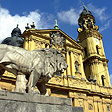MUSEUM OF BAVARIAN KINGS
Wittelsbach History and Castles at Hohenschwangau
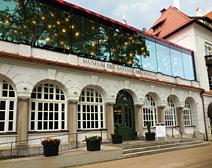 The fairy tale castle of Neuschwanstein with its towering spires has attracted tourist visitors to the south west corner for Bavaria since it was first built as a revival fantasy by King Ludwig II, sometimes referred to as Mad Ludwig for his palace building projects. He was inspired by the location for a castle palace while as a boy at his family’s castle palace of Hohenschwangau. The two castles are now rather joined forever, within view of one another in the scenic mountain land of lakes, like a father and son, one formal and rich and one of aspirational imagined medieval glory. Whether visiting the castles or with a shortage of time, the story of the family of the Wittelsbachs can now be explored at the Museum of Bavarian Kings (Museum der Bayerischen Könige).
The fairy tale castle of Neuschwanstein with its towering spires has attracted tourist visitors to the south west corner for Bavaria since it was first built as a revival fantasy by King Ludwig II, sometimes referred to as Mad Ludwig for his palace building projects. He was inspired by the location for a castle palace while as a boy at his family’s castle palace of Hohenschwangau. The two castles are now rather joined forever, within view of one another in the scenic mountain land of lakes, like a father and son, one formal and rich and one of aspirational imagined medieval glory. Whether visiting the castles or with a shortage of time, the story of the family of the Wittelsbachs can now be explored at the Museum of Bavarian Kings (Museum der Bayerischen Könige).
Wittlesbach Family Dynasty
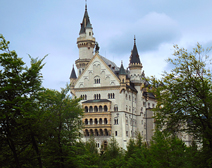 The Kingdom of Bavaria only lasted for 112 years, from the crowning of Maximillian Joseph I in 1806, and lasting until the end of the First World War in 1918, but the Wittelsbach dynasty is one of the oldest of Europe and its succession of Prince Bishops and German Electors makes it one of the great influential families of Europe. The Imperial Crown of the German and Holy Roman Emperors mostly followed the rival Hohenzollerns and the Habsburgs, but the Wittelsbachs were always just a step away, and did provide two Holy Roman Emperors to the wearers of the crown of Charlemagne.
The Kingdom of Bavaria only lasted for 112 years, from the crowning of Maximillian Joseph I in 1806, and lasting until the end of the First World War in 1918, but the Wittelsbach dynasty is one of the oldest of Europe and its succession of Prince Bishops and German Electors makes it one of the great influential families of Europe. The Imperial Crown of the German and Holy Roman Emperors mostly followed the rival Hohenzollerns and the Habsburgs, but the Wittelsbachs were always just a step away, and did provide two Holy Roman Emperors to the wearers of the crown of Charlemagne.
There were two lines of Wittlesbachs, the Bavarian line and the Palatine line, from the time when the Wittelsbachs also controlled much of the western region of Germany in the Rhineland. But curiously, the family which formed the Kingdom of Bavaria in 1806 were actually of the Palatine arm of the dynasty as the Bavarian line died out in 1777. After a family squabble called the War of Bavarian Succession, Elector Charles Theodore of the Palatine-Sulzbach branch took control of Bavaria, and his son Maximillian Joseph took the seat of Prince Elector until the end of the Holy Roman Empire in August of 1806, when Napoleon’s victories changed the map of Europe.
Kingdom of Bavaria
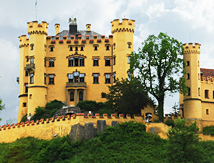 The Museum of the Bavarian Kings in Hohenschwangau tells the history of the Wittelsbach dynasty from its beginnings to the present day but the primary focus of the museum is on the efforts of Maximilian II, who commissioned the conversion of Hohenschwangau Castle into his summer residence, and on his son, "Mad“ King Ludwig II, the visionary originator of Neuschwanstein Castle, left to posterity represent the lofty ideals of kights and princes, but a very complex and idealized past.
The Museum of the Bavarian Kings in Hohenschwangau tells the history of the Wittelsbach dynasty from its beginnings to the present day but the primary focus of the museum is on the efforts of Maximilian II, who commissioned the conversion of Hohenschwangau Castle into his summer residence, and on his son, "Mad“ King Ludwig II, the visionary originator of Neuschwanstein Castle, left to posterity represent the lofty ideals of kights and princes, but a very complex and idealized past.
The museum is located at the edge of the Alpsee Lake in a former hotel called the Alpenrose, just a walk from the Hohenschangau Castle and Ticket Center. The exhibition encompasses the surrounding landscape and the castles into an interactive modern display of digitized documents, artifacts and some ceremonial servingware in gold and china. There are not a lot of actual royal items or crown jewels, which can be seen at the Residenz Palace in Munich (see Residence Bavarian Crown Jewels), but more techonlogical displays and backlit photo images to follow the story. In the former foyer of the old hotel is a large map which shows the ties by marriage of the Wittelsbachs throught the European lineage, even to the later Plantagenet English monarchy through the marriage of Philippa of Hainaut to Edward III (see Traitors Gate), long before the current Windsors, more connected to the Hohenzollerns.
The Hall of the Royal Castles
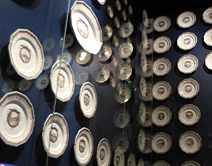 The heart of the museum is focused on the builders of the Neuschwanstein and Hohenschwangau Castles, King Ludwig II and his father King Maximilian II, who both shared a love for the stunning landscape of the Allgau and both fans of medieval heritage, even as their kingdom was enetering the modern industrial world and leaving chivilric ideals far behind. The two kings differed in one important way. Maximilian II regarded himself as a constitutional king with public support. His son Ludwig on the other hand was enamored of the unfettered power of France’s of Louis XIV, the Sun King, who expressed his power in the building of great palaces, so Ludwig spent a fortune on his own, but his ideal of former absolute monarchy was only a dream expessed in his archtectual tastes.
The heart of the museum is focused on the builders of the Neuschwanstein and Hohenschwangau Castles, King Ludwig II and his father King Maximilian II, who both shared a love for the stunning landscape of the Allgau and both fans of medieval heritage, even as their kingdom was enetering the modern industrial world and leaving chivilric ideals far behind. The two kings differed in one important way. Maximilian II regarded himself as a constitutional king with public support. His son Ludwig on the other hand was enamored of the unfettered power of France’s of Louis XIV, the Sun King, who expressed his power in the building of great palaces, so Ludwig spent a fortune on his own, but his ideal of former absolute monarchy was only a dream expessed in his archtectual tastes.
The Bavarian place in history owes more to its king‘s patronage of the arts, rather than military or political success. The Wittelsbachs fostered the revival of a number of impressive building and reconstruction projects, not only the Residenz in Munich and Ludwig’s palaces at Hohenschwangau, Linderhof (see Ludwig’s Linderhof and Grotto) , and Herrenchiemsee, but also the Greek inspired Pompejanum in Aschaffenburg (see Aschaffenburg Bishops Palace), and the Hall of Liberation at Kelheim. Ludwig II was a patron of Richard Wagner, whose taste for the Teutonic glories were in line with the king, and supported him even in exile in Switzerland (see Wagner Museum Lucerne).
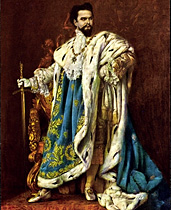 King Ludwig II, also Count Palatine of the Rhine and Duke of Bavaria, is largely presented in portraits as the handsome 18 year old he was when to came to the thrown in 1864, and not the 40 year old recluse paying bills from his bed in Linderhof near his death in 1886. King Ludwig II lost the thrown, disposed in that same year, under a perhaps trumped up charge of insanity due, hense the "Mad“ nickname. He drowned under mystrious circumstances, ruled a suicide at the castle of Lake Starnberg.
King Ludwig II, also Count Palatine of the Rhine and Duke of Bavaria, is largely presented in portraits as the handsome 18 year old he was when to came to the thrown in 1864, and not the 40 year old recluse paying bills from his bed in Linderhof near his death in 1886. King Ludwig II lost the thrown, disposed in that same year, under a perhaps trumped up charge of insanity due, hense the "Mad“ nickname. He drowned under mystrious circumstances, ruled a suicide at the castle of Lake Starnberg.
Nymphenburg Porcelain
The Royal Bavarian Service china of Nymphenburg Porcelain at the museum was a gift on the golden wedding anniversary of the last royal couple King Ludwig III and Queen Marie Therese in January 1918 in anticipation of the end of the monarchy when Germany lost the war. Ludwig III formally released his ministers and army from their oath of allegiance but never officially renounced his claim to the throne. After his death in 1921 the Crown Prince Rupprecht became head of the House of Wittelsbach. As the Nazi’s rose to power in his native bavaria, he was a staunch opponent and went into exile in Italy in 1939. As they allies took Bavaria in 1944, the Wittlesbach Family were interned for a time in a concentration camp. They still exist today, and the current head of the family, Duke Franz on Bavaria, now in his eighties, is thought by some Jacobite Scots seeking independence from England, to be the rightly heir to the thrown of Scotland, so there is still hope for Ludwig’s "mad“ dream.
Visiting the Museum of Bavarian Kings
The Alpsee Lake and castles of Hohenschwangau and Neuschwansteuin can be reached by car from Munich in about an hour, or from Friedrichshafen and Lindau on Lake Contanz in a half hour, or by bus tour from Munich. Admission to the Museum of Bavarian Kings can be included in a combination ticket to the castles of separately. Admission for the museum only is €9.50 for adults, €8 for Students and Seniors (Concession) and Children under 18 are free. Combination tickets to the castles including the museum vary from €20 to €29.50, which have to be bought at the Ticket Center. If the Wittlesbachs aren’t enough German royalty, the castles of the Hohehzollerns (see Hohenzollern Castle and Castle Sigmaringen) are about 40 minutes northwest. © Bargain Travel Europe
Best vacation deals compare prices in Bavaria at TripAdvisor
Web
Info
Hohenschwangau
These articles are copyrighted and the sole property of Bargain Travel Europe and WLPV, LLC. and may not be copied or reprinted without permission. Knights performace photo courtesy Burg Kriebstein.
See Also:
SCHLEISSHEIM PALACES & BAROQUE GARDEN PARK
BURG TRAUSNITZ MEDIEVAL CASTLE LANDSHUT
SEEWIRT AT THUMSEE - SIGMUND FRUED
HOTEL LUDWIG VON BAYER - ETTAL ABBEY
MITTENWALD ALPINE VILLAGE BAVARIAN ALPS

